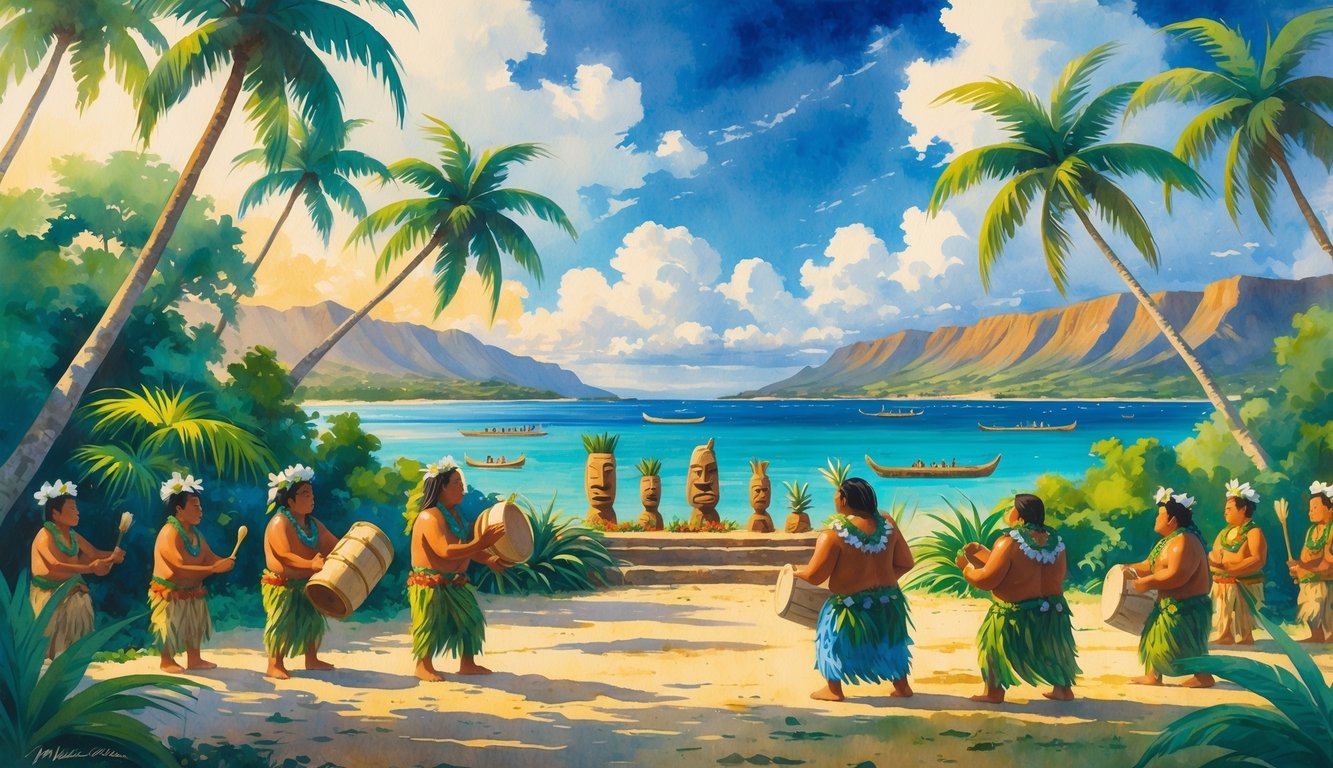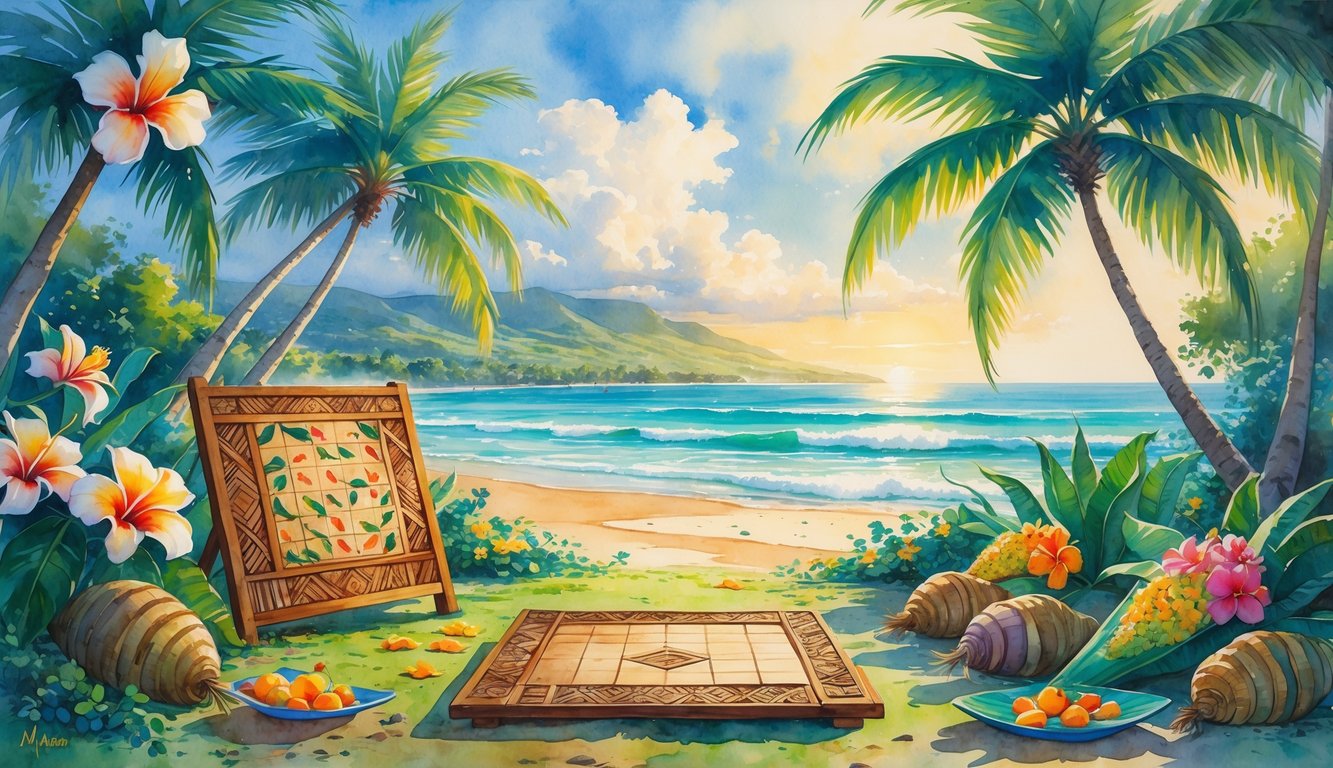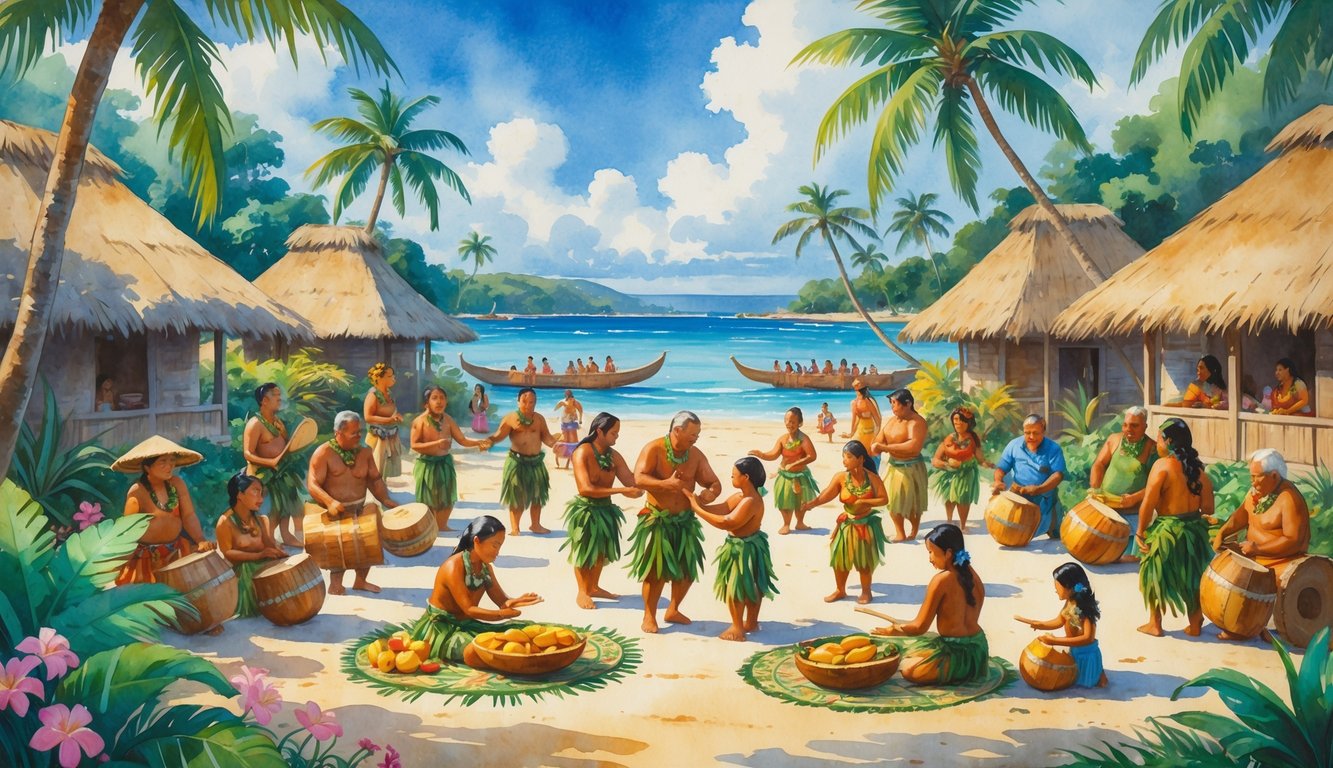When I first learned about Makahiki season, I felt amazed by how much it shapes Hawaiian culture. For many people in Hawaii, Makahiki marks a special time of year for celebration, rest, and gratitude for the land’s bounty.

Makahiki season is a key tradition that honors the Hawaiian god Lono and focuses on peace, harvest, and community spirit.

What makes Makahiki so fascinating is how the season connects to both the rhythm of the natural world and daily life. The time starts when the Makaliʻi star cluster (Pleiades) appears in the evening sky, bringing the rainy season and a break from work to enjoy games, feasts, and ceremonies.
These practices connect people to their roots and to each other. They help keep Hawaiian culture strong today.
If you want to know what makes this time so meaningful in Hawaii, there are many unique traditions and stories to discover about Makahiki season.
Origins and Historical Significance
Makahiki season stands as one of the most important times in Hawaiian tradition. It marks the ancient Hawaiian New Year, honors vital deities, and shows how deeply Hawaiians connect with nature and the stars.
Ancient Roots and the Hawaiian Calendar
I find it fascinating that Makahiki is tied so closely to the Hawaiian lunar calendar. The season begins in the wet months, usually around mid-November, and ends by late January or February.
This period lasts for four lunar months. In ancient times, Hawaiians used the moon’s phases and the appearance of certain stars to track time and plan key events.
During Makahiki, daily life shifts. Warfare stops, and people focus on peace, community, and giving thanks for the year’s harvest.
Events, feasts, and games take center stage. Everyone renews their bond with the ʻāina (land) and with each other.
The season is not just a holiday. It is woven into the structure of the year, ensuring that important traditions and spiritual practices stay central in people’s lives.
You can see these details in resources shared by Kaʻiwakīloumoku.
Connections to Lono and Other Akua
One part of Makahiki I always remember is its dedication to Lono, the god of agriculture, peace, and fertility. Lono, or Lonoikamakahiki, is the main akua (deity) honored during this time.
Hawaiians believe Lono brings rainfall, growth, and prosperity. People hold special ceremonies to give offerings, or hoʻokupu, to Lono.
The community carries a wooden figure called Akua Loa around the island. They visit each district so people can give their gifts.
Smaller images, called akua poko, are used at local gatherings. Old stories say that when the first rains fall, Lono arrives from Kahiki, the ancestral homeland.
His presence reminds everyone to rest from conflict and celebrate abundance with music, sport, and joy. The National Park Service at Haleakalā describes these customs in detail.
Makaliʻi and the Pleiades
The rising of Makaliʻi, or the Pleiades star cluster, signals the start of Makahiki. When Makaliʻi appears in the eastern sky after sunset, it marks the transition into the new year and the coming of Lono.
Ancient Hawaiians watched the sky closely. They used this appearance to confirm when to begin Makahiki activities.
The stars helped them keep their lunar calendar accurate and tied the celebration to the natural cycles of the year. Makaliʻi and the Pleiades are still important today.
This shows how ancient Hawaiian culture combined astronomy and spiritual practice. Observing these stars linked people to both the land and sky.
Ceremonies and Rituals
Makahiki season includes meaningful ceremonies and special traditions. These rituals show respect for the land, the gods, and unite people through offerings and sacred customs.
Offerings and Tribute
During Makahiki, giving offerings and tribute plays a big role. People bring gifts called hoʻokupu, such as crops, fish, kapa cloth, or other valuable items.
They give these offerings to honor the god Lono, who is linked to fertility, rain, and the harvest. Each district collects its tribute, called ʻauhau, and presents it to the chief or a priest.
This supports the community and shows gratitude for a good harvest. The act builds a positive relationship with the gods and shows unity among the people.
Ceremonies often include prayers, chants, and feasting. Everyone, from chiefs to farmers, takes part in this tradition.
The ritual of bringing hoʻokupu stands at the heart of the season’s meaning. It emphasizes both community and spirituality.
You can read more about makahiki offerings and ceremonies.
Heiau and Sacred Practices
Many Makahiki rituals take place at a heiau, which is a sacred stone temple. Priests and chiefs perform spiritual ceremonies there.
They use the ahu, or stone altars, to present offerings and conduct rituals for cleansing and guidance. Makahiki ceremonies in heiau follow strict rules known as kapu.
These rules protect the sacredness of the rituals and ensure everyone acts with respect. Prayers are said for blessings, rain, and a bountiful harvest.
Sometimes, a procession of the Akua Loa, an image of Lono, travels around the island, blessing the land. Spiritual cleansing is also important.
Special practices help people clear away bad luck and start fresh for the new year. These rituals, along with feasts and games, help everyone reconnect with their beliefs and each other.
Learn more about the importance of heiau and ceremonial rituals during Makahiki at the National Park Service page on Makahiki rituals.
Seasonal Timing and Natural Cycles

Makahiki season follows natural patterns. It begins when the star cluster Makaliʻi, also known as the Pleiades, rises in the evening sky.
The season signals big changes in agriculture and daily life for me and many others in Hawaii.
Alignment with the Rainy Season
The start of Makahiki lines up with Hawaii’s rainy season, usually from mid-November to late January or February. These months bring needed rainfall that soaks the soil, making it ideal for planting and growing crops like kalo.
The rain helps the land recover from the dry, sunny months of kau, the season before Makahiki. Increased rainfall boosts the fertility of the earth and helps farmers prepare for important harvests.
During Makahiki, the rains support new life and encourage planting for the next year. People depend on this time to renew the land’s abundance.
The extra water feeds plants, fills streams, and helps fish ponds. This makes it easier for families to gather food.
Because the rain is linked to Lono, the god of agriculture and fertility, it is also seen as a blessing for both people and the land.
Transition from Kau to Makahiki
I see a clear shift when we move from kau, the dry and sunny season, into Makahiki. As the days grow shorter and clouds gather, traditions mark the end of hard farm work and the start of a new year filled with rest and celebration.
Makahiki is not just about the weather changing. It is also when farmers finish their harvest and bring offerings from crops like kalo to the makahiki festival.
These gatherings depend on the cycles of the lunar calendar and the sighting of Makaliʻi in the sky, which signals the first night of the new season. The ending of kau and the beginning of Makahiki reminds me to slow down and give thanks for the year’s harvests.
The community comes together for ceremonies, sports, and games, all while honoring the land and the rain that made a good harvest possible. For more on the connection between Makaliʻi and the start of Makahiki, visit this overview of Makahiki.
Feasting and Celebration
During Makahiki season, I see traditions that bring communities together through food, music, and joyful gatherings. These important months let me celebrate prosperity and connect with my roots by honoring our cultural practices.
Traditional Foods and Imu
Feasting plays a big part in Makahiki celebrations. I look forward to food prepared in an imu, which is an underground oven.
Cooking this way is a tradition that takes time and teamwork. It brings out flavors and creates a sense of community.
Some of the main foods I often enjoy include kalua pig, sweet potatoes, taro, and fish. Breadfruit and yams, both important crops in Hawaii, hold a place of honor on the table.
Kapa is used to wrap some foods before cooking, adding extra meaning to the meal. Sharing these foods is more than just eating.
It is a way to show respect for the land’s bounty and to recognize the hard work of those who tended the crops. This communal eating highlights the unity and prosperity that Makahiki represents.
More details on these customs can be found at the Hawaiian Cultural Center.
Dancing, Hula, and Festivities
Music, dancing, and hula are at the heart of Makahiki festivities.
I join in to celebrate with lively chants, dances, and songs for Lono, the god of peace and agriculture.
Drums and rattles create a lively beat as people wear handmade costumes and woven leis.
Hula tells stories about the season, ancient gods, and the bounty of the land.
Dancers perform with care and joy.
Participants dress in kapa cloth and natural adornments, adding to the festive mood.
Games such as ‘ulu maika (Hawaiian bowling), spear throwing, and wrestling bring fun and challenge.
These activities help me feel close to my community.
Friendly rivalries and traditions make the season full of learning and laughter.
For more on these joyful activities, visit this Hawaiian culture page.
Games and Sports
During Makahiki season, games and sports fill the celebration with excitement.
People take a break from work, show their pride, and strengthen their bodies and minds through these activities.
Competitive Sports and Play
People play traditional games during Makahiki that are both fun and challenging.
Wrestling, called mokomoko, tests strength and skill.
Participants also compete in mock battles that focus on bravery and teamwork.
Racing plays a big part in the season.
The kūkini, or foot races, let runners show their speed and fitness.
Many join in, making racing a highlight for families.
Other challenges build stamina and bring people together for friendly competition.
These games give everyone a chance to rest, feel proud, and celebrate with the community.
You can see these traditions at Makahiki celebrations.
Board and Water Sports
Some games take place away from the field.
Playing kōnane, a board game like checkers, tests strategy and observation.
This shows that Makahiki games value clever thinking as well as physical strength.
ʻUlu maika is another favorite.
Players roll rounded stones between two stakes, aiming carefully.
Water sports are also important during Makahiki.
Surfing and swimming let people show grace and balance in the waves.
These games bring everyone to the beach for rest and playful competition.
Read more about Makahiki games and their history to see why they matter in Hawaiian life.
Social Structure and Community Involvement

Makahiki season brings my community together.
The roles people hold, from chiefs to families, guide how we celebrate, share resources, and keep our culture alive.
Role of the Aliʻi and Konohiki
During Makahiki, the aliʻi (chiefs) lead and organize the tribute system.
People bring food, goods, and other offerings to the aliʻi to show respect and support community needs.
The konohiki, local land stewards, manage each ahupuaʻa, or land division, and make sure resources are shared fairly.
The aliʻi and konohiki work together to make decisions about sports, ceremonies, and when celebrations begin.
The aliʻi, seen as having mana (spiritual power), guide the whole community.
The structure of moku (districts) and ahupuaʻa gives every group a voice in the season.
Careful planning helps communities come together in peace and gratitude.
ʻOhana and Cultural Identity
My ʻohana, or family, is central to Makahiki traditions.
Families organize festivities, prepare food, and teach younger generations about cultural practices.
Through games and storytelling, children learn values and teamwork.
Events encourage everyone, from elders (kupuna) to children (keiki), to join in.
This shared celebration strengthens our Hawaiian identity and pride.
Even today, community Makahiki festivals show how families pass on knowledge and keep ties strong.
Makahiki connects kanaka maoli—Native Hawaiians—by keeping our practices alive across generations.
Periods of Peace, Rejuvenation, and Spiritual Renewal
During Makahiki, our community pauses conflict and focuses on well-being.
Traditions encourage aloha, balance, and gratitude, bringing healing and unity.
A Time for Peace and Rest
Makahiki gives everyone a break from daily tensions.
Warfare and fighting stop, so people can rest without fear.
Families gather, celebrate, and strengthen their bonds.
The land also gets time to heal.
Farming slows down, giving the soil a chance to recover.
This helps prepare for future harvests.
People share what they have and help each other.
Communities gather for games, feasts, and ceremonies that build unity and trust.
These traditions help people appreciate nature and each other.
You can read more at Season of the Makahiki Ritual.
Spiritual Significance and Cleansing
Makahiki is about more than rest; it is a time for spiritual renewal.
We honor Lono, the god of peace, fertility, and rain.
The Makaliʻi (Pleiades) star cluster signals the start of this special season.
Special rituals clear away negative feelings and thoughts.
Ceremonies include chants, offerings, and other practices to cleanse the spirit and bring calm.
Makahiki gives me a chance to reflect and forgive.
People use this time to let go of old conflicts.
The spirit of aloha reminds everyone to care for themselves and others.
Rejuvenation helps mind and spirit, bringing balance and hope for the new year.
To learn more about the spiritual meaning behind Makahiki, see Makahiki: Celebrating Renewal, Peace, and the Bounty of the Land.
Legacy and Continuing Relevance
Makahiki season still shapes Hawaiian culture and identity today.
I see its traditions continue through festivals, education, and historic sites that hold deep meaning for people in Hawaii.
Modern Revivals and the Hawaiian Renaissance
The Makahiki festival found new life during the Hawaiian Renaissance.
This cultural movement, starting in the 1970s, restored lost traditions, language, and practices.
Schools now teach children ancient chants, hula, and games.
During Makahiki celebrations, I see community gatherings with music, food, and traditional sports like ‘ulu maika (stone rolling) and mokomoko (boxing).
These events reconnect people to their roots and remind them of Makahiki’s peaceful, mindful spirit.
People focus on honoring Lono and giving thanks for the land’s bounty.
Hawaiians, especially youth, want to reclaim their history.
Public festivals and ceremonies are now common on O‘ahu, Maui, and Hawai‘i Island.
The revival of Makahiki continues to support identity, pride, and community.
Makahiki’s Role in Hawaiian Pride
For me, Makahiki is more than a festival.
It stands for Hawaiian pride and unity.
Events teach values like respect, community, and living in balance with nature.
Today, schools and families work to keep these lessons alive.
I see children learning about their ancestors through chants and traditional games.
During Makahiki, people share stories about legendary leaders like Lonoikamakahiki and King Kamehameha I.
These stories connect everyone to old customs and heroic deeds.
My friends and I feel pride as we carry on these traditions and strengthen our ties to Hawaiian culture.
People honor the land’s abundance, celebrate peace, and reflect on the year.
When I join Makahiki festivities, I notice everyone feels welcome and valued, no matter their background.
Notable Sites and Historical Events
Certain places stand out during Makahiki. Each has its own ties to history.
For example, Kealakekua Bay marks the spot where Captain James Cook landed during the Makahiki season in 1779. This arrival led to one of the most famous encounters between Hawaiians and Europeans.
People often honor King Kamehameha I during Makahiki. He united the islands and encouraged peace.
When I visit historic sites or join public ceremonies, I see how these locations connect modern celebrations with the past. Markers at these sites share the story of important Makahiki events.
Leaders gather at sacred spaces to offer ho‘okupu (gifts) and praise the gods. Their actions follow the traditions of their ancestors.




